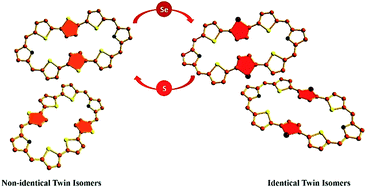Two non-identical twins in one unit cell: characterization of 34π aromatic core-modified octaphyrins, their structural isomers and anion bound complexes†
Abstract
Four different core-modified planar 34π octaphyrins (10, 11, 13, and 15) which exhibit rotational isomerism have been synthesized and characterized both in solution and solid states. Octaphyrins 10, 11 and 13 show two inseparable isomers A and B which crystallize in the same unit cell. However, 15 forms two identical isomers of A. Structurally, the two isomers in 10, 11 and 13 (A and B) are different only in the ring inversion of one of the thiophene or selenophene rings present in the terthiophene subunit of the macrocycle. In isomer A, the middle thiophene or selenophene rings are inverted, while in isomer B, the terminal thiophene rings are inverted. The 1H NMR spectrum of these macrocycles shows peaks assignable to protons of both the isomers in toluene D8. The single crystal structure analysis of 10 reveals the presence of both isomers 10A and 10B in a single unit cell with the P21/n space group. Both the isomers exhibit aromatic behaviour in the freebase form. Protonation of pyrrole nitrogens leads to exclusive formation of isomer B for 10 and 11. However, both the isomers are present upon protonation of 13 where the central heterocyclic ring of terthiophene subunits has thiophene and selenophene rings. Octaphyrin 15 crystallizes in the P21/c space group and exclusively isomer A was formed in the reaction. Protonation of pyrrole nitrogens leads to significant increases in aromaticity as revealed by 1H NMR chemical shift data. The NICS values calculated for the individual heterocyclic rings before and after protonation support such a conclusion. The AICD plots exhibit clockwise orientation of current density vectors suggesting the presence of diatropic ring current in the octaphyrins. Energy calculations at the M06L/CC-pVTZ//M06L/6-31G** level qualitatively account for exclusive stabilization of a particular isomer relative to the other upon protonation. To the best of our knowledge 10 represents the first example in expanded porphyrin chemistry where two different structural isomers crystallize in a single unit cell.



 Please wait while we load your content...
Please wait while we load your content...